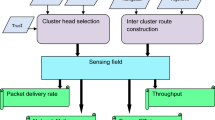Abstract
Organic Computing has similar characteristics of organism which can be self-adjustment for a variety of conditions. Moreover, during the wireless communication technological evolution progress, WiMAX (Worldwide Interoperability for Microwave Access) offers ability of high capacity and far distance transmission. WiMAX provides high-speed access and a coverage range across several kilometers, but the actual coverage range was merely a few kilometers due to the shelter of buildings or terrain. IEEE 802.16 working group designed 802.16j-based RS (Relay Station) to overcome above problem. In this paper, we present a mechanism called Self-Optimization Handover Mechanism. This mechanism is using GPS (Global Positioning System) navigation system to gather the related information for the position and combine the mobility characteristics of Mobile Relay Station. Especially, the concept of Self-Optimization of Organic Computing has been integrated into this mechanism. There are some advantages for this new mechanism, including: (1) The base station can provide advance plan and select the path. (2) The mechanism can reduce the number of possible handover and hop. (3) The mechanism can reduce the time of channel scan.











Similar content being viewed by others
References
Choi, S., Hwang, G.-H., Kwon, T.-R., Lim, A., & Cho, D.-H. (2005). Fast handover scheme for real-time downlink services in IEEE 802.16e BWA system. In IEEE vehicular technology conference (VTC 2005), June 2005 (Vol. 3, pp. 2028–2032).
Kumbuza, X., & Ventura, N. (2006). Using the global positioning system (GPS) to add intelligence to wireless handover in WLAN. In IEEE international electro/information technology conference (EIT 2006), MI USA, May 2006.
Rott, A. (2007). Self-healing in distributed network environments. In IEEE advanced information networking and applications workshops (AINAW 2007), Niagara Falls, Canada, May 2007.
Institute of Electrical and Electronics Engineers (2006). IEEE standard for local and metropolitan area networks. Part 16. Air interface for fixed and mobile broadband wireless access systems amendment. 2. Physical and medium access control layers for combined fixed and mobile operation in licensed bands and corrigendum 1. IEEE Std. 802.16e, February 2006.
Vaughan-Nichols, S.J. (2004). Achieving wireless broadband with WiMax. Computer, 37(16), 10–13.
Ntagkounakis, K., Dallas, P., Sharif, B., & Valkanas, A. (2007). Adaptive TDD synchronisation for WIMAX access networks. IET Communications, 1(6), 1218–1223.
Tang, Y.-L., Yao, Y., & Lo, C.-H. (2010). A node decision improvement of channel assignment scheme for WiMax mesh networks. Journal of Internet Technology, 11(2), 135–142.
Mach, P., & Bestak, R. (2008). WiMAX throughput evaluation of conventional relaying. Telecommunications Systems, 38(1–2), 11–17.
Zhu, S., Ding, Z., & Markarian, K. (2010). Multi-source multi-destination relay network: constrained optimisation for higher diversity. IET Communications, 4(12), 1484–1494.
Institute of Electrical and Electronics Engineers (2009). IEEE draft amendment to IEEE standard for local and metropolitan area networks. Part 16. Air interface for fixed and mobile broadband wireless access systems multihop relay specification. IEEE Draft 802.16j/D9, February 2009.
Ozdural, O. C., & Liu, H. (2007). Mobile direction assisted predictive base station switching for broadband wireless systems. In IEEE international conference on communications (ICC 2007), Glasgow, Scotland, June 2007.
Lianhai, S., Fuqiang, L., Li**, W., & Yusheng, J. (2008). Predictive group handover scheme with channel borrowing for mobile relay systems. In IEEE international wireless communications and mobile computing conference (IWCMC 2008), Crete Island, Greece, Aug. 2008.
Schmeck, H. (2005). Organic computing—a new vision for distributed embedded systems. In IEEE international symposium on object-oriented real-time distributed computing (ISORC 2005), Washington, DC, USA, May 2005.
Chang, J.-M., Hsu, C.-C., Chao, H.-C., & Chen, J.-L. (2009). Using A* algorithm to avoid dead end problem for geographic forwarding. Journal of Internet Technology, 10(4), 363–368.
Sheu, J.-P., Chang, C.-C., Lo, K.-W., & Deng, C.-W. (2010). Design and implementation of a navigation system for autonomous mobile robots. International Journal of Ad Hoc and Ubiquitous Computing, 6(3), 129–139.
Fey, D., Komann, M., Schurz, F., & Loos, A. (2007). An organic computing architecture for visual microprocessors based on marching pixels. In IEEE international symposium on circuits and systems (ISCAS 2007), New Orleans, USA, May 2007.
Delicado, J., Delicado, F. M., & Orozco-Barbosa, L. (2008). Study of the IEEE 802.16 contention-based request mechanism. Telecommunications Systems, 38(1–2), 19–27.
Ali-Yahiya, T., Beylot, A.-L., & Pujolle, G. (2010). Downlink resource allocation strategies for OFDMA based mobile WiMAX. Telecommunications Systems, 44(1–2), 29–37.
Acknowledgements
The authors would like to thank the editor and the anonymous referees. This work was supported in part by the Nation Science Council of Taiwan, R.O.C., under contract NSC98-2221-E-197-009-MY3
Author information
Authors and Affiliations
Corresponding author
Rights and permissions
About this article
Cite this article
Chang, JM., Hsiao, WT., Chen, JL. et al. Navigation-based self-optimization handover mechanism for mobile relay stations in WiMAX networks. Telecommun Syst 55, 17–24 (2014). https://doi.org/10.1007/s11235-013-9747-5
Published:
Issue Date:
DOI: https://doi.org/10.1007/s11235-013-9747-5




